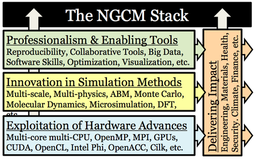Centre for Doctoral Training in Next Generation Computational Modelling
- Homepage
- http://www.ngcm.soton.ac.uk/
- Started
- 1st November 2013
- Research Team
- Susanne Ufermann Fangohr, Thorsten Wittemeier, Kieran Selvon, Alvaro Perez-Diaz, David Lusher, Ashley Setter, Emanuele Zappia, Hossam Ragheb, Ryan Pepper, Stephen Gow, Jan Kamenik, Paul Chambers, Robert Entwistle, Rory Brown, Joshua Greenhalgh, James Harrison, Jonathon Waters, Ioannis Begleris, Craig Rafter
- Investigators
- Hans Fangohr, Ian Hawke, Peter Horak
Mission Statement
Computational modelling is critically important to modern science and engineering. The achievements of modern research and their rapid progress from theory to application are increasingly underpinned by computation.
Consequently, there is strong pull from UK government, industry and academia for skilled scientists and engineers with the broad, state-of-the art training necessary to innovate in this area.
Computational approaches are hailed as a new third pillar of science and engineering - in addition to empirical and theoretical work. While its breadth makes computation almost as ubiquitous as mathematics as a key tool in science and engineering, it is a much younger discipline and stands to benefit enormously from systematic training provision, connecting simulation techniques across established domains, and establishing best practice in software engineering for research.
To meet the current and emerging computational challenges presented by science and industry, extensive and significant cross-disciplinary innovation is required across the entire "NGCM Stack" (see figure above), which depicts three distinct layers of computational activity that are typically considered separately, but need to be treated together to exploit the potential of computer simulation.
From bottom to top this innovation will require: (a) smart new approaches to exploit powerful novel hardware (e.g., multi-core processors, GPU computing, Intel phi, etc.); (b) new multi-scale, multi-physics and coarse-graining paradigms that can cope with large-scale simulations, in order to capture complex processes; (c) significant advances in professionalism and enabling tools for simulation, e.g., large-scale data visualization, best practice in simulation standards, and big data curatorship.
Rather than train PhDs to meet these challenges piecemeal across fragmented research activities divided along disciplinary lines, the NGCM integrates them together within a comprehensive, and inter-disciplinary centre for advancing computational modelling.
Our Doctoral Programme
The Southampton Centre for Doctoral Training in Next Generation Computational Modelling provides an innovative training programme for post-graduate students to: •be trained in state-of-the-art best practice for computational modelling •be exposed to industrial and real-world problems •become cross-disciplinary communicators •become cross-disciplinary computational problem solvers
The NGCM benefits from dedicated physical space in a new building , and an extended network of diverse industrial and academic partners providing strategic input, hands-on collaboration, sponsorship and internship opportunities. Our partners include blue-chip multinationals (e.g., BAE Systems, EADS, HGST, IBM, Microsoft, Rolls Royce, Seagate, Xyratex), computational technology firms (e.g., Intel, Kitware, Microsoft, NAG, nVidia, Simul8, iSys), government research labs (e.g., NIST, Sandia, DSTL, Data Storage Institute), and international academic institutions (e.g., Berkeley, US; Mainz, Germany; Oslo, Norway; Perth, Australia; Rostock Germany). In this way we will enable and encourage the cross-fertilization between modelling paradigms, modelling communities, and application domains that has been identified by industry as critical to the future impact simulation modelling.
Categories
Life sciences simulation: Bioinformatics, Biomedical, Biomolecular Organisation, Epigenetics, Evolution, Medical Imaging, NextGen Sequencing, Structural biology, Swarm Behaviour, Systems biology
Physical Systems and Engineering simulation: Advanced Materials, Astrophysics, Biomechanics, CFD, Combustion, Complex fluids, Data Acquisition, Diffusion, Electromagnetism, Fiber Optic Communications, Flight simulation, Fluid Dynamics, fluid structure interaction, Magnetohydrodynamics, Magnonics, Materials, Micromagnetics, Particle Collisions, Photonics, QCD, Semiconductors, Spintronics, Tribology, Turbulence, Wave propagation
Socio-technological System simulation: Value-driven design
Algorithms and computational methods: Agents, Boundary elements, Cellular automata, Density functional Theory, Evolutionary Algorithms, FFT, Finite differences, Finite elements, Machine learning, Minimum Energy Paths, Molecular Dynamics, Monte Carlo, Multi-core, Multi-physics, Multi-scale, Multipole methods, Optimisation, Quantum Chemistry, Smoothed Particle Hydrodynamics, statistical analysis, Support Vector Machine, Symbolic calculation
Visualisation and data handling methods: colour perception, Data Aggregation, Data Management
Simulation software: Abaqus, AMBER, Ansys, CASTEP, COMSOL, Finmag, Fluent, Gromacs, Nmag, Onetep, OpenFOAM, StarCD
Visualisation and data handling software: Blender, HDF5, Mayavi, MySQL, ParaView, Povray, Pylab, PyTables, VisIt, Visual Python, VMD, VTK, Xmgrace
Software Engineering Tools: Eclipse, Emacs, gdb, Git, Jenkins, Mercurial, Redmine, Sublime Text, SVN, valgrind, Vim
Programming languages and libraries: Boost, C, C++, CUDA, Fortran, IPython/Jupyter Notebook, Java, Julia, Mathematica, MPI, OpenACC, OpenCL, OpenMP, Pandas, PETSc, Python, R, Tcl, Verilog, VHDL
Computational platforms: ARCHER, Cloud computing, Docker, FPGA, GPU, Iridis, Linux, Mac OS X, Vagrant, VirtualBox, Xeon Phi
Transdisciplinary tags: Complex Systems, Computer Science, Data Science, e-Research, Education, HPC, NGCM, Scientific Computing, Software Engineering, Visualisation
